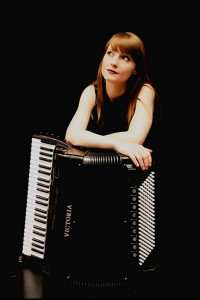 Margherita Berlanda is a young and talented accordionist, whose interests focus mainly on the fascinating field of contemporary music. Margherita has great technical skills and is always ready to explore new soundscapes. In this interview, she talks about her musical and personal voyage.
Margherita Berlanda is a young and talented accordionist, whose interests focus mainly on the fascinating field of contemporary music. Margherita has great technical skills and is always ready to explore new soundscapes. In this interview, she talks about her musical and personal voyage.
When did your passion for the accordion begin?
‘My father owned an accordion, so this instrument was part of my visual and musical world as a child. Learning how to play came as a natural consequence. I started at age eight, and was immediately enthralled by it.’
Contemporary music features prominently in your concert repertoire. What technical and communicative aspects of this period do you find most captivating?
‘I have always preferred classical music to the folk repertoire, which has a very deep-rooted tradition in my region of origin, Trentino Alto-Adige. But I can distinctly remember when my teacher of the time introduced me to some pieces by Precz, Krzanowski and Lundquist. It was like an epiphany. That musical language, so new, won me over immediately. The accordion is a relatively recent instrument and is constantly being perfected, so I believe it can express itself at its best in contemporary music, which tries to explore its communicative and technical potential in depth. I love the technical and expressive challenges posed by contemporary music, both to performers and their public. Also, this musical genre mirrors and comments on the many facets and contradictions of our world, using a complex, composite-sometimes even chaotic- language. Speaking about today’s world it is important, and also fundamental to do so through art, in all its forms.’
In spite of your young age, you have taken part in a plethora of national and international competitions. Is there an event or an anecdote from one of these important experiences, that you would like to share with us?
‘Every competition is an opportunity for growth and for contact with new musical worlds. I have fond memories of the time I took part in the International Chamber Music Competition “Luigi Nono” in Venaria, because thanks to it – and to the concert I was so lucky to perform at – I met Gianluca Castelli, a talented composer from Turin with whom I have collaborated for five years now. Gianluca is the author of exquisitely sophisticated scores for accordion: duos, concerts, and chamber music, such as “Una storia, un racconto” (“A tale, a story”) dedicated to Alberto Colla, which I executed as a world premiere for my final Konzertexamen at the Hochschule fuer Musik in Trossingen, Germany.’
You gave several concerts in Italy and abroad. As far as listening skills and attention are concerned, do you find any major differences between an Italian and a foreign audience?
‘Music is held in great consideration in the whole of Mitteleuropa, or Central Europe – the area I am more familiar with. There, even the most experimental music projects get enthusiastic response from the public. In Italy I have often been asked to adapt my repertoire to the tastes of an ideal “average audience” that was to come to the concert. There have been several cases in which I had to turn down a concert because I wouldn’t give up my ideals and my predilection for classical music – which is, I must admit, the only area of music I know well and feel comfortable with when performing live. Having said this, I cannot complain about Italian concert-goers, who, even if not overabundant, are usually very warm and attentive. At any rate, I always try to introduce some new elements in my repertoire.’
 In the past you have played not only as a soloist, but also in duos with the accordionists Ghenadie Rotari and Rebekka Zwick, the French guitarist François Stride, the soprano Baiba Urka, and, above all, with the cellist Nicolò Nigrelli. What are the key aspects of these musical projects?
In the past you have played not only as a soloist, but also in duos with the accordionists Ghenadie Rotari and Rebekka Zwick, the French guitarist François Stride, the soprano Baiba Urka, and, above all, with the cellist Nicolò Nigrelli. What are the key aspects of these musical projects?
‘I was so fortunate to collaborate with outstanding musicians who share my respect for music, as well as a desire to explore and live the chamber music experience at its fullest -as a process of mutual growth, both at a musical and personal level. Once again, our common trait is the choice of our musical repertoire, which ranges from Baroque music to music written specially for the duo performing it.’
You are an active member of “Azione Improvvisa Ensemble”, which won the competition “Open Creazione Contemporanea 2018 – Pergine Festival”. Can you tell us about this ensemble’s repertoire?
‘Azione Improvvisa (which in English translates as Sudden Action, but in Italian is a play on words echoing the word improvisation) originates from the idea of a young researcher and composer, Raul Masu, who wanted to combine instruments so diverse and apparently irreconcilable as the theorbo, the accordion, the electric guitar and electronic music. With such a varied ensemble, we will perform music written specially for us by both new and well-known composers, such as Annachiara Gedda, Andrea Portera, Stefano Alessandretti, Giorgio Colombo Taccani. Our ensemble performed Taccani’s piece ‘Blind Trust’ for a monographic record on his work to be published by GuitArt, one of the leading Italian labels in classic guitar recordings.
In the Azione Improvvisa project we intend to use ancient music scores alongside a contemporary music repertoire, in order to draw parallels between these two musical languages and highlight their common elements. Just think about the complexity and the degree of conceptualization behind some pieces by Ars Subtilior.’
You have started a very close collaboration with Andrea Fontanari, a visual artist with whom you founded the art open space “Anomalia” in September 2017. Can you tell us about this fascinating project?
‘Anomalia is an open space where all arts can converge, a small ‘Factory’ in Andy Warhol’s terms. This place –much smaller, really, than Warhol’s- is based near Trento and is a permanent research workshop for contemporary art, ranging from music and sculpture to the performing arts. It promotes contamination projects based on the idea of Gesamtkunstwerk – The Total Artwork. Anomalia collaborates with Pergine Festival (based in Pergine Valsugana) and with Spazio Musica Festival in Cagliari.’
 Speaking of collaborations, you have worked with Vatican Radio, Bayerische Rundfunk and RAI Slovenia. Where did these opportunities come from?
Speaking of collaborations, you have worked with Vatican Radio, Bayerische Rundfunk and RAI Slovenia. Where did these opportunities come from?
‘As it happens, opportunities arise from the trust and esteem of the people you get to know. I owe my collaboration with Vatican Radio to Maestro Corrado Rojac of the Music Conservatorium G. Tartini of Trieste, while I should thank Maestro Hans Maier, Head of the Department of Accordion at Staatliche Hochschule fuer Musik Trossingen for the opportunity to work with Bayerische Rundfunk and German television. As for RAI Slovenia, this opportunity came from journalist Jari Jarc, who used to study with me.’
As far as the field of education is concerned, you have worked as a teaching assistant in pre-academic courses at the Conservatorium “G. Tartini” in Trieste and collaborated with various schools in Germany. What are your views on teaching?
‘To me, teaching is a mission. A teacher needs to be a mentor, but also a good listener. Teachers should listen to their students just as much as students listen to their teachers. They ought to be generous when giving advice, divesting themselves of their knowledge and passing it on to their students. Teaching music-or art in general-is both a privilege and an ordeal. It is an incredibly delicate mission, since the teacher both leads and influences the student’s artistic progression.’
Traduzione Laura Pedrotti
Questo post è disponibile anche in: Italian

 English
English Italiano
Italiano 





Leave a comment
You must be logged in to post a comment.